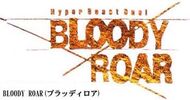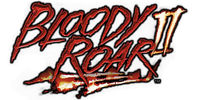Bloody Roar (ブラッディロア Buraddi Roa) is a series of fighting games created by Hudson Soft, and developed together with Eighting. The series has been published by multiple companies including Virgin Interactive, Activision and Konami.
Hudson Soft later became a subsidiary of Konami.
The Games[]
The series began in 1997 under the name Beastorizer. The game's theme incorporated anthropomorphism, where the player has the ability to transform into a half-human, half-animal creature known as a Zoanthrope. The game would appear under the name Bloody Roar when ported to the PlayStation in 1998, which would become the permanent title thereafter. There are three Bloody Roar sequels, plus a game based on a sidestory set between 3 and 4 on the Nintendo GameCube which was later ported to the Xbox.
The following is a complete list of the games in the series:
| Title | Year | Platforms | |
|---|---|---|---|

|
Beastorizer Bloody Roar Bloody Roar: Hyper Beast Duel |
1997 | Arcade, PlayStation |

|
Bloody Roar 2 Bloody Roar II: The New Breed Bloody Roar 2: Bringer of the New Age |
1999 | Arcade, PlayStation |

|
Bloody Roar 3 | 2000 | Arcade, PlayStation 2 |

|
Bloody Roar: Primal Fury Bloody Roar: Extreme |
2002 | GameCube, Xbox |

|
Bloody Roar 4 | 2003 | PlayStation 2 |
In 2008, Bloody Roar and Bloody Roar 2 was available to download in the Playstation Network for PSP and PS3
Gameplay[]
Bloody Roar has kept somewhat the same controls over the series, particularly after the second opus who determined the base of the games mechanics. A button each for both punch and kick, the beast (transform/attack) button and a fourth button that has been either a throw button, a block button, an evade button and/or a Rave button (in Bloody Roar only). In Bloody Roar: Extreme only, a fifth button is available to use Hyper Beast Form.
The gameplay experience of Bloody Roar is a combination of classic and current style side scrolling fighting games. They are 3D fighting games with a strong focus on meter management and many 2D fighter elements. Strategically, the core gameplay revolves around trying force situations where your fighter is in their stronger Beast form while your opponent is stuck in their weaker Human form. [1]
Although some of the characters have remained almost identical through all four games others have changed completely. For example Yugo has a completely different move set in the last titles compared to his original in the first and Bakuryu has stayed almost the same apart from a few extras which are relevant to the games evolution over time and generations.
Characters in Bloody Roar have command moves and standard moves. Standard moves are the combination style moves from games such as Tekken, where the player must press different buttons to create strings, sometimes pressing the directional pad in one of the eight directions at the same time as pressing the Punch, Kick or Beast button. Command moves are special moves that require a rolling technique (for example ![]() ) and inputting certain commands with the directional pad, like Street Fighter.
) and inputting certain commands with the directional pad, like Street Fighter.
Each character has around 14 "suggested" combination techniques listed in the manuals, most of these can be varied into many different ways, allowing nearly 40 - 70 combination techniques with each character. Every character also comes with at least 8 command moves, which can be incorporated into cancel points in these standard moves or combos. These cancel points from character to character can be around 20 - 40 in each character's combo palette. These cancel points, when utilized with command moves, can then be canceled once more, allowing the player to begin a new strategy with adequate timing.
As well as this, the combat system has 3 types of dodging techniques, a heavy and light block that spans over 3 parts of the body (high, mid, low) and "scratch" techniques, which can break guards from dead angles and a series of command counters, throws and vanishing attacks.
Bloody Roar 4, the latest game in the series, may be the most complex of the series, with the largest fighter roster of 17 characters, and the ability to earn more moves by earning experience in Career mode.
Series Rights[]
At the beginning of the franchise, in 1997, Bloody Roar was developed and published by Eighting and Hudson Soft, giving the Intellectual Proprety (IP) to these two companies.
In 2012, Hudson Soft ceased to exist as a company and was merged with Konami Digital Entertainment [2]. Since then, the rights of the series go to Konami which already worked on Bloody Roar 4 before published it in 2003.
No name is really affiliated with the franchise despite Kenji Fukuya [3] who worked on the all Bloody Roar instalments as director.
In Other Media[]
Bloody Roar was adapted into a manga drawn by Maruyama Tomowo. The manga was released in two volumes during 2001.
Reception[]

Until Bloody Roar 4, the series instalments were generally received with positive reviews from the critics with Bloody Roar 2 being the peak of success of the series in term of critical acclaim and worldwide sale. The series was praised for its graphic (especially for the two first games) and its smooth and fast-pacing gameplay with responsive control, but what made it interesting for the public was the transformation mechanics relatively unprecedented in fighting games.
Bloody Roar suffered from the comparison with more popular 3D fighting games like Tekken, Soulcalibur or Dead or Alive, the sale never quite competed with them and the series was judged having a less addictive gameplay. As saying by Ashley Bates, from Culture Vulture, "Bloody Roar has never been at the pinnacle of the fighting game genre, but it’s always been a popular series within the fighting game community. They were never the most technically sophisticated games on the markets, but they offered an enjoyable spectacle of shape-shifting fighters knocking the snot out of the each other." [4]
Despite having a good run, with the first four instalments being well received, the last opus, Bloody Roar 4, was heavily criticized for being incomplete with an unsatisfactory and drastic change in the gameplay, the game fails to connect with the critic and the public and it's still considered to have "killed" the franchise.
Even with the lack of new entries since 2003, the Bloody Roar series has still a fair share of followers, mostly among retro-gamer praising the first two opus, which appear time to time in retro gaming tournaments. Also, its transformation mechanic, where the fighters can change themselves into a beast, helped making this games memorable among the players. Additionally, Bloody Roar: Extreme (Nintendo Gamecube version), mostly considered, among the fan, to be the more advanced gameplay-wise, still has its very own fan community and it's regularly played as tournament using game console emulator (following the discontinuation of the Nintendo Gamecube).
Nowadays, Bloody Roar is regularly cited, among the videogame players and medias, as a forgotten franchise in need of a revival as testified by Chris Hepburn, in One Single Player "If Bloody Roar was to continue as a modern fighter, the possibility exists for it to be a more cinematic and visually impressive game with great combat would be sure to impress players" [5].
Trivia[]
- In the first three games, artwork by artist Naochika Morishita, also known as CARAMEL MAMA, was used for concept artwork and in game cut scenes.
- For their 2000 single "My Console," the Italian eurodance group Eiffel 65 include Bloody Roar along with several other popular PlayStation titles in the song's lyrics.
- The Raizing game Dimahoo was going to feature an original beastman guest character which would be related to Bloody Roar. [6]
- In 2015, Watch Mojo ranked Bloody Roar 1st in his top "Forgotten Fighting Games" [7][8]
External Links[]
Citations[]
- ↑ https://wiki.gbl.gg/w/Bloody_Roar_Extreme/FAQ
- ↑ https://www.eurogamer.net/articles/news120405hudsonkonami
- ↑ https://www.mobygames.com/developer/sheet/view/developerId,63264/
- ↑ https://culturedvultures.com/best-fighting-games/
- ↑ https://www.onlysp.com/top-five-fighting-games-rematch/
- ↑ http://shmuplations.com/raizing/
- ↑ https://www.youtube.com/watch?v=woYTklsD5Yc
- ↑ https://www.watchmojo.com/suggest/Top+10+Forgotten+Fighting+Games
